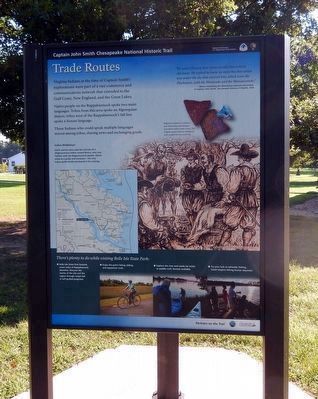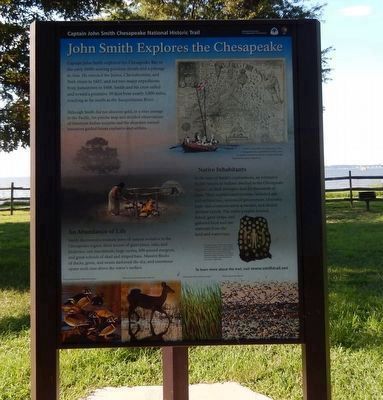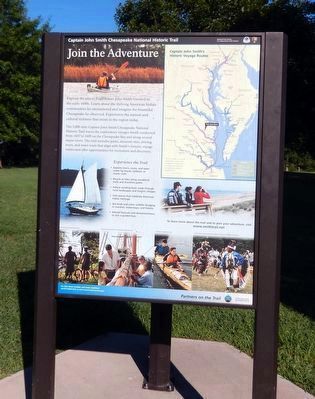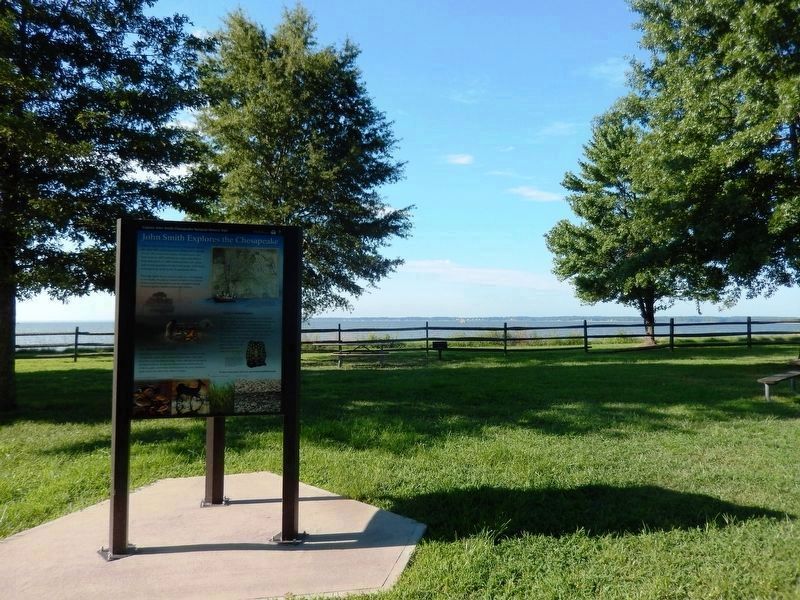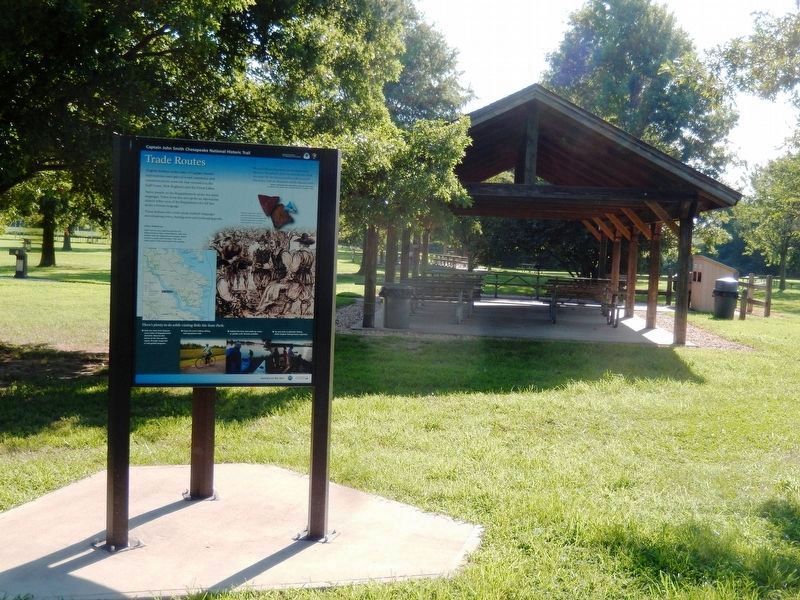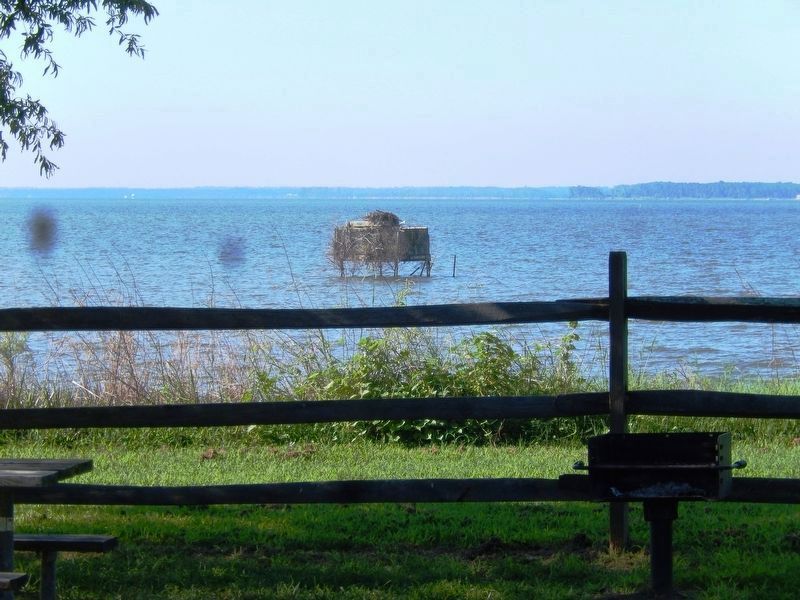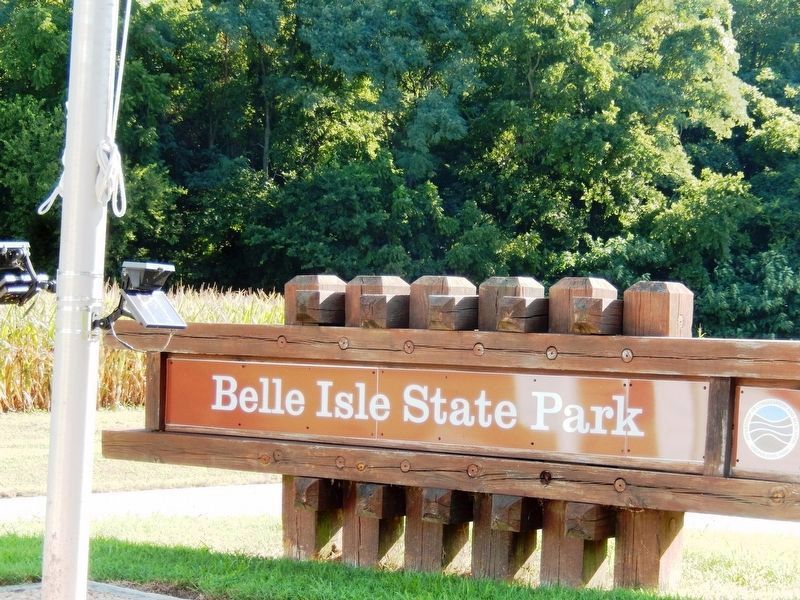Near Lancaster in Lancaster County, Virginia — The American South (Mid-Atlantic)
Trade Routes
Captain John Smith Chesapeake National Historic Trail
(panel 1)
Trade Routes
Virginia Indians at the time of Captain Smith’s explorations were part of a vast commerce and communications network that extended to the Gulf Coast, New England, and the Great Lakes.
Native people on the Rappahannock spoke two main languages. Tribes from this area spoke an Algonquian dialect; tribes west of the Rappahannock’s fall line spoke a Siouan language.
Those Indians who could speak multiple languages moved among tribes, sharing news and exchanging goods.
“We asked (Mosco) how many worlds (Amoroleck) did know. He replied he knew no more but that which was under the sky that covered him, which were the Powhatans, with the Monacans and the Massawomeks.”
—Mosco translating the Mannahoac prisoner Amoroleck, in Captain John Smith, The General History of Virginia, 1624.
(captions)
Indiana Middleman-Smith and his crew used the services of a Wighcocomoco Indian Mosco, who was familiar with the Rappahannock people. Mosco acted as guide and translator—the only Indian guide Smith mentioned in his writings.
Regional variations in pottery and shells help archeologists determine Indian trade routes. The English traded with the Indians as well, usually for furs and food.
(sidebar)
There’s plenty to do while visiting Belle Isle State Park:
• Belle Isle State Park features seven miles of Rappahannock shoreline. Discover the stories of the site and the region through ranger-led or self-guided programs.
• Enjoy the park’s hiking, biking, and equestrian trails.
• Explore the river and creeks by motor or paddle craft. Rentals available.
• Try your luck at saltwater fishing. (Valid Virginia fishing license required.)
(panel 2)
John Smith Explores the Chesapeake
Captain John Smith explored the Chesapeake Bay in the early 1600s seeking precious metals and a passage to Asia. He traveled the James, Chickahominy, and York rivers in 1607, and led two major expeditions from Jamestown in 1608. Smith and his crew sailed and rowed a primitive 30-foot boat nearly 3,000 miles, reaching as far north as the Susquehanna River.
Although Smith did not discover gold, or a river to the Pacific, his precise map and detailed observations of American Indian societies and the abundant natural resources guided future explorers and settlers.
Native Inhabitants
At the time of Smith's explorations, an estimated 50,000 American Indians dwelled in the Chesapeake region—as their ancestors had for thousands of years. Their sophisticated societies included arts and architecture, systems of government, extensive trade and communication networks, and shared spiritual beliefs. The native people hunted, fished, grew crops, and gathered food and raw materials from the land and waterways.
An Abundance of Life
Smith discovered a treasure trove of natural wonders in the Chesapeake region: thick forests of giant pines, oaks, and hickories; vast marshlands, huge turtles, 800-pound sturgeon, and great schools of shad and striped bass. Massive flocks of ducks, geese, and swans darkened the sky; and enormous oyster reefs rose above the water's surface.
To learn more about the trail visit www.smithtrail.net
(captions)
Smith’s remarkably accurate map of the Chesapeake Bay (published in 1612), and his spirited written accounts of a lush landscape inspired European migration.
Decorative shells-such as those found on this ceremonial robe-were valuable in the American Indian’s trading network that extended for hundreds of miles. This robe (which may have belonged to paramount chief Powhatan) was crafted from four elk skins and adorned with more than 17,000 shells.
Wood ducks and other waterfowl flourished
The forests and lowlands teemed with deer
Cattails grew thick in pristine marshes
Flocks of geese filled the sky
(panel 3)
Join the Adventure
Explore the places Englishman John Smith traveled in the early 1600s. Learn about the thriving American Indian communities he encountered and imagine the bountiful Chesapeake he observed. Experience the natural and cultural richness that exists in the region today.
The 3,000-mile Captain John Smith Chesapeake National Historic Trail traces the exploratory voyages Smith conducted from 1607 to 1609 on the Chesapeake Bay and along several major rivers. The trail includes parks, museum sites, driving tours, and water trails that align with Smith's historic voyage routes and offer opportunities for recreation and discovery.
Experience the Trail
• Explore rivers, coves, and open water by kayak, sailboat, or motor craft.
• Bicycle or hike along woodland trails and shoreline paths.
• Follow winding back roads through rural landscapes and historic villages.
• Visit places that celebrate American Indian heritage.
• See birds and other wildlife foraging in marshes, waterways, and forests.
• Attend festivals and demonstrations, or join a guided tour.
To learn more about the trail and to plan your adventure, visit
www.smithtrail.net
(captions)
Captain John Smith’s Historic Voyage Routes
“Here are mountains, hils, plaines, valleys, rivers, and brookes all running most pleasantly into a faire Bay compassed but for the mouth with fruitful and delightsome land.”
– John Smith, 1612
Overlooking the Susquehanna River
Students aboard Discovery at Jamestown Settlement
Kayakers explore the trail
Indian dance demonstration at Jefferson Patterson Park and Monument
Erected by National Park Service, U.S. Department of the Interiror.
Topics and series. This historical marker is listed in these topic lists: Colonial Era • Exploration • Native Americans • Settlements & Settlers • Waterways & Vessels. In addition, it is included in the Captain John Smith Chesapeake National Historic Trail series list. A significant historical year for this entry is 1607.
Location. 37° 46.394′ N, 76° 35.544′ W. Marker is near Lancaster, Virginia, in Lancaster County. Marker can be reached from Belle Isle Road, half a mile south of Creek Landing Road, on the right when traveling south. The marker is located in the picnic area of Belle Isle State Park. Touch for map. Marker is at or near this postal address: 1632 Belle Isle Road, Lancaster VA 22503, United States of America. Touch for directions.
Other nearby markers. At least 8 other markers are within 6 miles of this marker, measured as the crow flies. Bewdley (approx. 2.3 miles away); Morattico Historic District (approx. 2.3 miles away); St. Mary’s Whitechapel (approx. 2.8 miles away); Queenstown (approx. 2.9 miles away); Lancaster County / Richmond County (approx. 4.1 miles away); Birthplace of Washington’s Mother (approx. 4.2 miles away); St. Mary’s White Chapel (approx. 4.3 miles away); Cyrus Griffin’s Birthplace (approx. 5.8 miles away). Touch for a list and map of all markers in Lancaster.
Also see . . .
1. Captain John Smith Chesapeake National Historic Trail. National Park Service (Submitted on August 25, 2016.)
2. Belle Isle State Park. Virginia Department of Conservation and Recreation (Submitted on August 25, 2016.)
Credits. This page was last revised on June 27, 2021. It was originally submitted on August 24, 2016, by Don Morfe of Baltimore, Maryland. This page has been viewed 378 times since then and 25 times this year. Photos: 1, 2, 3, 4, 5, 6, 7. submitted on August 24, 2016, by Don Morfe of Baltimore, Maryland. • Bernard Fisher was the editor who published this page.
